Jian Liu’s worm farm tips
Jian Liu, from Camberwell, discusses her worm farms. For more worm farm tips, you can find her at www.instagram.com/melbourne.foodforest. In May 2021, Jian’s garden featured on Gardening Australia – watch the 7 minute segment.
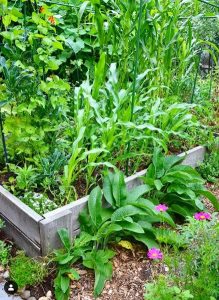
I’ll confess at the outset, you’re dealing with a worm farm nerd. I’m one of those people who has four(!) worm farms in my suburban backyard.
I am such a big advocate of worm farms, you’ll hear me harping on about them to everyone. Unlike compost bins there’s no turning required, no smell and they don’t take up much space – they suit every situation, whether you live in an apartment or have a large backyard.
If you want to grow your own fruit & veggies, have a growing indoor plant collection, or even if you aspire to have an ornamental garden, worm farms are an absolutely essential part of a flourishing and sustainable garden! They not only enable us to ‘close the loop’ on our food waste and scraps, they also produce a free, concentrated fertiliser that plants simply go nuts for.
In this article, I discuss 3 overall questions followed by my top 10 tips.
I’ve already got a compost bin or Bokashi, so what’s in it for me and why should I bother?
Worm farming is different to both composting and Bokashi – each of these systems are complements and do different things. The simple way I like to think of it is worm farms produce a concentrated ‘fertiliser’, composts produce bulk material for plants to grow in and Bokashi bins produce a half-fermented product which then needs to go into a worm farm or compost to finish decomposing.
Type of composter |
What to feed it? |
What comes out? |
| Worm farm Great for apartments and gardens, small and big. |
Mostly kitchen fruit and veggie scraps, coffee grounds – but also you can add some leaves, cardboard etc. | Fertiliser – concentrated. |
| Compost bins Not suitable for apartments, more for gardens. |
Bulk garden prunings, mowed grass, autumn leaves, and also kitchen fruit & veg scraps. I mostly add any excess citrus to the compost bin. | Bulk material for plants to grow in. |
| Bokashi Great for apartments or any household. |
All kitchen scraps and also leftover meals, meat and dairy. | Half-fermented output that needs to be added to a worm farm, compost bin or soil to further decompose before using. |
These systems are all complements to each other.
The end product that you’re aiming for with worm farms is worm poo/castings (the technical term is vermicompost). Unlike your pet poo, there is no smell at all and it is fudgy in texture! This is the absolute pinnacle of garden fertilisers, which is why you’ll sometimes hear worm poo referred to as ‘black gold’. In my experience, the difference between plants that have had some black gold versus those that haven’t is huge.
If you’re in a small living space, such as an apartment, then compost bins generally won’t be practical, but worm farms and Bokashis are still great options. If you have more space to work with, then you should consider adding a worm farm as a complement to your existing compost bin.
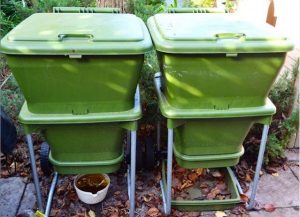
I’ve already got enough to do, how much work is this?
It is actually very little work. Do you have 30 seconds to spare a week? 30 seconds or so is all it takes to walk up to the worm farm, dump some food in and have a quick look to ensure everything’s going smoothly. Unless you’re like me and find them fascinating and find yourself opening the farm just to check on your little worm pets … that takes a bit longer.
In summer, you’ll need to put in some frozen food on super-hot days. A few times a year you will need to spend a bit of time harvesting the vermicompost. It’s much less work than a compost bin because there is no turning of heavy materials! And the longer you do it the easier it gets, until it becomes habit and fits seamlessly into your lifestyle.
How much is this all going to cost me?

I’ve seen heaps of great DIY options (just google them) using a polystyrene box or esky – it will cost you next to nothing to upcycle. If you’re looking at a pre-made worm farm then, depending on your council area, you might be able to get them cheap from Compost Revolution. You can also get second hand worm farms off Gumtree – often complete with worms! Depending on what style of worm farm you choose, the price can range from $40 for a worm cafe (the tiered worm farms) to $350 for a ‘hungry bin’, which is the size of a wheelie bin (I’ve got two of these and they are totally worth the investment!).
Unless you’ve got a friend with a worm farm who is willing to give you a few handfuls, you’ll need to spend some money for the worms to get you started. Worms can be quite expensive from the hardware chains, and often come as worm ‘eggs’ rather than live worms. I bought mine from a local gardener off Gumtree. The more worms you buy the quicker your worm farm kicks into gear, but I’d recommend at least 1,000 to get you started.
Here are some of my 10 hot tips to foster happy, blissful worms.
1. Location, Location, Location
The biggest single failure for worm farms is not choosing the right site for them. If you get this right, everything else is easy. Worms don’t like it too hot or too cold. The ideal location is indoors – in a shed or laundry. Otherwise, in the shadiest spot in your garden, with no direct sun – it’s great for those spots where nothing else will grow. I have mine under a deciduous tree next to the house which lets in some light in winter but is sheltered from any direct sun in summer.
2. Give your worms nice bedding to sleep in
Worms need somewhere to eat and sleep. Some people say to use just coconut coir or newspaper. I create my own mostly free bedding blend using whatever materials I have on hand. A good mix is autumn leaves, shredded newspaper/cardboard and soaked coir (about $3 a block). If you have some homemade compost that has finished decomposing, you can also add that into the mix. The key is to aim for bedding that is light and airy but also retains some moisture. I shred my newspaper by hand as we don’t have a shredder – it’s quick and easy if you tear along the grain. It can be done in front of the TV and I find it a little therapeutic (a bit like popping bubble wrap!). Once finished, the bedding should feel like a wrung out sponge, not too wet but just mildly damp.
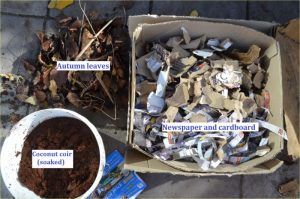
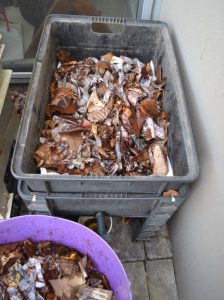
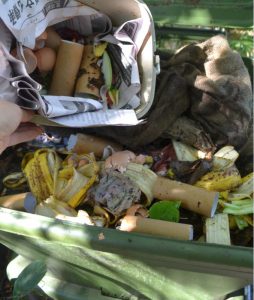
3. Balance
Just like with a good compost, a worm farm is all about a balance of nitrogen-rich materials (like all your household food scraps) and brown materials. Line your compost caddy with newspaper (as a bonus, this also helps to keep your compost caddy clean) and regularly throw in toilet rolls, paper bags and other bits of cardboard as they are produced over the week. You can also throw in a handful of autumn leaves once a week if you don’t have cardboard – I collect them by the sackful in winter and it lasts me the whole year as garden mulch and worm farm food.
4. Not too wet, not too dry
Worms are like goldilocks, they want their moisture levels to be just right. Too wet and they might think that they are drowning and try to escape. A few thousand worms on the lid trying to escape is not a pretty sight and something you won’t forget easily! If you get the basic recipe right then you shouldn’t need to add any extra water. Always leave the farm’s tap open with a bucket under it so that the liquid is continuously dripping out and the worm farm doesn’t flood. I only get a little bit of liquid out of mine, but that’s a sign of a balanced worm farm.
5. Keep me warm but not too hot
Ensure that you have a worm blanket just inside the lid as this helps to buffer any temperature changes. Good free worm blankets are hessian bags, thick damp newspaper or pizza boxes, or even those squares of wool people often get in home-delivered meals. If it’s freezing outside, cover the entire farm with some old carpet – I don’t tend to bother doing this as Melbourne is quite mild. In summer, on scorching 35+ degree days, I freeze their food. Or you can freeze bottles of water and leave them inside the lid.
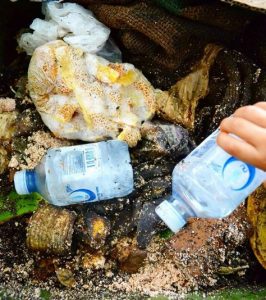
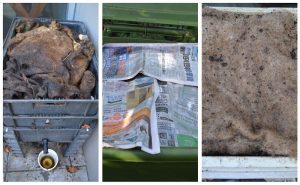
6. Don’t feed me too much
Especially when starting out, less is more with food. Let the worms finish what you’ve fed them before giving them more. Too much food can create acidic conditions and bad smells. Once they settle in, your worms will build up their numbers and become hugely efficient processors of food. Once they’re on a roll, a standard worm farm should be able to process all your family’s food scraps with ease. All of our household’s food scraps go into the worm farm but we still don’t actually produce enough scraps, so I also connect with Sharewasters (around 10 different local households rop off their waste to me on an ad hoc basis).
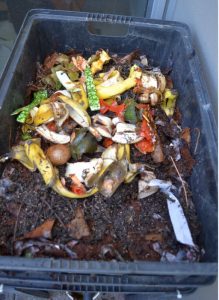
7. Feed me right
Feed your worms any fruit or veggie scraps from the kitchen but don’t add any dairy, cooked meals or meat. I find that their favourite foods are watermelon and rockmelon rinds and coffee grounds. A bit of bread or cooked grains (rice, beans) that have gone off are fine. Don’t put in any large garden prunings or large volumes of garden materials as they’ll just overload your worm farm (they should go into your compost instead). Just remember: the quality of your worm castings will depend on what you feed your worms. If you give them a good balance of foods from the garden, then your worm castings will also be well-balanced in nutrients.
8. Avoid large amounts of acidic products
I put in citrus peel, onion and tomatoes, just not a lot. You’ll notice that the worms avoid them but there are still other critters in the farm helping to break these down. If you’ve got a glut of mandarins or oranges, or if you’re making a bulk amount of passata and have lots of tomato skins, leave these for the compost. Otherwise the small amounts consumed by a regular household are fine to add to the worm farm.
9. Eggshells!
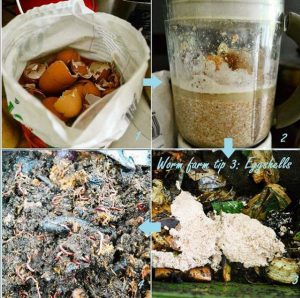
Don’t spend any money on those ‘worm farm conditioners’ that are marketed in hardware chains – I don’t believe in buying food or amendments for my worm farm. Don’t forget that we keep worms to process our waste not to support the creation of more waste! A free worm farm conditioner is eggshells – these help with point 8 above because they have a high pH (basic) and will keep your worm farm in balance. They also add valuable calcium to your worm castings which will help your plants grow strong and healthy. The best way to apply your eggshells is to save up a few weeks’ worth, puree it to a fine paste and then add it to the worm farm. You only need to do this a few times a year. Alternatively, you can just crush up with your hands and throw them in, but this is not as effective as pureeing as it takes a lot longer to break down.
10. The fun part, harvesting worm poo!
Only harvest castings when your first tray is full. This will be at least 6 months after you first started but could be longer depending on how much you feed your worms. I tend to only do it twice a year – around the two major planting seasons in autumn and spring – and store up any extra castings that I harvest in a tub to use year-round. The castings are so potent you only need a little when planting out or adding to your indoor plants or garden beds. A good way to use them is to add a little to every planting hole as you’re planting out seedlings – this way, each seedling has a pocket of goodness to feed it all season!
There are a lot of misconceptions regarding the liquid that comes out of your worm farm. This is actually ‘leachate’ (not worm wee or worm tea, which is completely different and is actually worm poo soaked in water). Have a read online, as there are lots of interesting articles which go into the science behind it. Leachate is the juice of half decomposing veggies and fruits and can contain pathogens. If you do use it I’d recommend only on established fruit trees as it can harm young plant. If you are using on veggies, dilute and use in moderation. As mentioned above, you shouldn’t be producing a lot liquid in a balanced worm farm anyway.
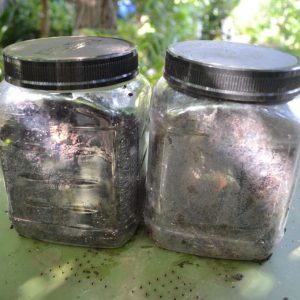
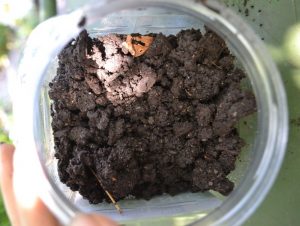
* * * * *
I got my worms from someone called Tony in Ashburton (see his website). He makes his own worm farms and also sells worms in huge sacks of vermicompost for a fantastic price (much cheaper than from any nursery or hardware shop). You also get to visit his flourishing garden fed with worm castings! This is a great option for those in the Eastern suburbs, whereby you pickup from his house. Contact Tony by phone (0422 042 634) or email.

The balance to get the worm farm is so different between areas. I used to live near Brisbane but now in Cairns so huge difference in temperature. Set up a unit and was so stressful as worms escaped and dying as holes in the ‘breathing space of the legs of Tumbleweed’ product. Is it true that adult worms will try to get away from their young hence the swarming out of the area? Or is my box so out of balance as ‘instructions’ did recommend 1/2 bucket of water each week to maintain your farm? I am also wondering if over-feeding would result in heat being created from vege breakdown as soil is really warm beyond recommended temperatures. Even putting ice packs in but don’t last long so even gone up to water bottle size or will zi know have worm icicles? So want this to work so any help would be appreciated. Cassie
Hi Jian,
I have a worm farm and, when harvesting the worm poo, I find that there are a lot of worms in the castings even though the tray is full of worm poo. Is this normal or am I doing something wrong?
Hoping you can help.
These tips are so great! I wish I’d read this before I bought worm farm conditioner! I’ve got 5 worm farms around the garden and I’m still constantly learning. There’s a lot of valuable info in this article so thank you Jian! Seeing how good it is for the garden and teaching the kids how to reduce our impact on landfill has been the best thing about 2020.
Great post which has totally inspired me to start a worm farm. Could I ask where you get coconut coir from? Can I use coir peat bricks from Bunnings?
Hi Yuri,
All coir is coconut coir. You can buy it at many nurseries as well as Bunnings.
Great comments, Jian. So few people discuss the importance of creating beautiful fertiliser out of previously waste materials and they will eat anything! How many orange peels and onion skins have gone into the bin because people think they won’t get eaten.
Jian, for weeks I have been searching the net, learning as much as I can about worm farming.Your article is the best: straight forward, practical and not too complicated. I am left with one big question: where can I get hold of some compost worms?
I have several milking goats, so we have plenty ofd old mouldy straw and hay, blrnded with goat manure and urine.
We also use a composting toilet, so we have humanure, with a lot of saw-dust. I expect to pay for them. I have emailed two suppliers, wanting to buy from them, and not heard back.
I am situated not far from Cooma. If you yourself cannot sell me some, maybe you could help put me in contact with someone who will.
Thanking you.
Mark Layton
Hi Mark that’s really lovely feedback, and very heartening to hear. It is my goal to share my gardening experiences in no-fuss, straight-forward way and I’m glad you found it helpful!
I got my worms from Tony in Ashburton, he runs the website http://wormz.com.au. I expect it may be too far from you and not possible with the current restrictions. You could check out gumtree or marketplace if there’s anyone closer. There are also online sellers e.g. https://www.wormlovers.com.au/compost-worms (this is where I bought my Hungry Bin worm farm from) that look like they have worms in stock and free delivery too. And if you get desperate there is always the big green shed…
All the best with your worm quest!
Thanks – very informative and a great summary!
Fabulous article Jian, Very clear, with some excellent tips that I’m excited about applying to my worm farm. In fact, you’ve inspired me to set up another one! Thank you 🙂
Wonderfully helpful information, many thanks 🙂
I’m inspired to start! Finally.